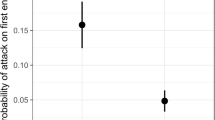Abstract
The transfer of nutrients between organisms is a common feature of mutualism. The production of these food rewards is often assumed to be costly. Estimation of the costs of producing food rewards is important for understanding the overall effects of the interaction on fitness. When food rewards are harvested by several species differing in foraging behavior, costs to the producer may differ. The larvae of many species in the butterfly family Lycaenidae produce secretions consumed by tending ants. Here I report that three North American ant species, Formica perpilosa, Dorymyrmex sp. (smithi complex), and Forelius foetida, had no negative effect on the duration of development and adult size of the lycaenid Hemiargus isola. Moreover, tending by the ant Formica perpilosa significantly enhanced larval growth, resulting in butterflies that were 20% heavier than their untended counterparts. Tending by the ants Dorymyrmex sp. (smithi complex) and Forelius foetida had no effect on butterfly weight. Tended, nonfeeding larvae lost 69% more weight than untended, nonfeeding larvae. Taken together, the results suggest that, although ant tending imposes a physiological cost, H. isola larvae use behavioral or physiological mechanisms to compensate or overcompensate for nutrients lost to ants.
Similar content being viewed by others
References
Addicott JF (1979) A multispecies aphid-ant association: density dependent and species-specific effects. Can J Zool 57:558–569
Atsatt PR (1981) Lycaenid butterflies and ants: selection for enemyfree space. Am Nat 118:638–654
Baylis M (1989) The role of nutrition in an ant-lycaenid-host interaction. Ph.D. dissertation, University of Oxford
Baylis M, Pierce NE (1992) The effects of ant mutualism on the foraging and diet of lycaenid caterpillars. In: Stamp NE, Casey TM (eds) Caterpillars: ecological and evolutionary constraints on foraging. Chapman Hall, New York
Bhatkar A, Whitcomb WH (1970) Artificial diet for rearing various species of ants. The F1 Entomol 53:230–232
Bristow CM (1984) Differential benefits from ant attendance to two species of Homoptera on New York ironweed. J Anim Ecol 53:715–726
Boggs CL (1986) Reproductive strategies of female butterflies: variation in and constraints on fecundity. Ecol Entomol 11:7–15
Boucher DH, James S, Leeler KH (1982) The ecology of mutualism. Ann Rev Ecol Syst 13:315–347
Cushman JH, Rashbrook VK, Beattie AJ (1993) Demonstration of benefits to both participants in a lycaenid-ant association. Ecology (in press)
DeVries PJ (1988) The larval ant-organs of Thisbe irenea (Lepidoptera: Riodinidae) and their effects upon attending ants. Zool J Linn Soc 94:379–393
DeVries PJ (1991) Mutualism between Thisbe irenea butterflies and ants, and the role of ant ecology in the evolution of larval-ant associations. Biol J Linn Soc 43:179–195
DeVries PJ, Baker I (1989) Butterfly exploitation of an ant-plant mutualism: adding insult to herbivory. J New York Entomol Soc 97:332–340
Elgar MA, Pierce NE (1988) Mating success and fecundity in an ant-tended butterfly. In: Clutton-Brock TH (ed) Reproductive success. University of Chicago Press, Chicago, pp 59–75
Eliot JN (1973) The higher classification of the Lycaenidae (Lepidoptera): a tenative arrangement. Bull Brit Mus (Nat Hist) Entomol 28:373–505
Fiedler K (1991) European and North West African Lycaenidae and their associations with ants. J Res Lepid 28:239–257
Fiedler K, Maschwitz U (1989) Functional analysis of the myrmecophilous relationships between ants (Hymenoptera: Formicidae) and lycaenids (Lepidoptera: Lycaenidae). I. Release of food recruitment in ants by lycaenid larvae and pupae. Ethology 80:71–80
Fiedler K, Hölldobler B (1992) Ants and Polyommatus icarus immatures (Lycaenidae) — sex-related developmental benefits and costs of ant attendance. Oecologia 91:468–473
Herrera CM (1987) Components of pollinator “quality”: comparative analysis of a diverse insect assemblage. Oikos 50:79–90
Hinton HE (1951) Myrmecophilous Lycaenidae and other Lepidoptera—a summary. Proc Trans S London Entomol Nat Hist Soc 1949–1951:111–175
Honek A (1993) Intraspecific variation in body size and fecundity in insects: a general relationship. Oikos 66:483–492
Malicky H (1970) New aspects on the association between lycaenid larvae (Lycaenidae) and ants (Formicidae, Hymenoptera). J Lep Soc 24:190–202
Maschwitz U, Wust M, Schurian K (1975) Blaudlingsraupen als Zuckerlieferanten für Ameisen. Oecologia 18:17–21
Peterson MA (1993) The nature of ant attendance and the survival of larval Icaricia acmon (Lycaenidae). J Lep Soc 47:6–16
Pierce NE (1983) The ecology and evolution of symbioses between lycaenid butterflies and ants. PhD dissertation, Harvard Univ, Cambridge, MA
Pierce NE (1987) The evolution and biogeography of associations between lycaenid butterflies and ants. In: Harvey PH, Partridge L (eds) Oxford surveys in evolutionary biology, vol 4
Pierce NE, Easteal S (1986) The selective advantage of attendant ants for the larvae of a lycaenid butterfly, Glaucopsyche lygdamus. J Anim Ecol 55:451–462
Pierce NE, Kitching RL, Buckley RC, Taylor MFJ, Benbow KF (1987) The costs and benefits of cooperation between the Australian lycaenid butterny, Jalmenus evagoras, and its attendant ants. Behav Ecol Sociobiol 21:237–248
Price PW, Bouton CE, Gross P, McPheron BA, Thompson JN, Weis AE (1980) Interactions among three trophic levels: influence of plants on interactions between insect herbivores and natural enemies. Ann Rev Ecol Syst 11:41–65
Robbins RK (1991) Cost and evolution of a facultative mutualism between ants and lycaenid larvae (Lepidoptera). Oikos, 62:363–369
Savignano DA (1990) Field investigations of a facultative mutualism between Lycaeides melissa samuelis Nabokov (Lycaenidae), the Karner blue butterfly, and attendant ants. PhD dissertation, University of Texas, Austin
Schemske DW, Horvitz CC (1984) Variation among floral visitors in pollination ability: a precondition for mutualism specialization. Science 225:519–521
Scott JA (1986) The butterflies of North America. Stanford Univ Press, CA
Sokal RR, Rohlf FJ (1981) Biometry (Second Edition). WH Freeman & Co., New York
Thompson JN (1982) Interaction and coevolution. John Wiley Press, New York
Winer BJ, Brown DR, Michels KM (1991) Statistical principles in experimental design (Third edition). McGraw-Hill, New York, pp 169–172
Author information
Authors and Affiliations
Rights and permissions
About this article
Cite this article
Wagner, D. Species-specific effects of tending ants on the development of lycaenid butterfly larvae. Oecologia 96, 276–281 (1993). https://doi.org/10.1007/BF00317742
Received:
Accepted:
Issue Date:
DOI: https://doi.org/10.1007/BF00317742




